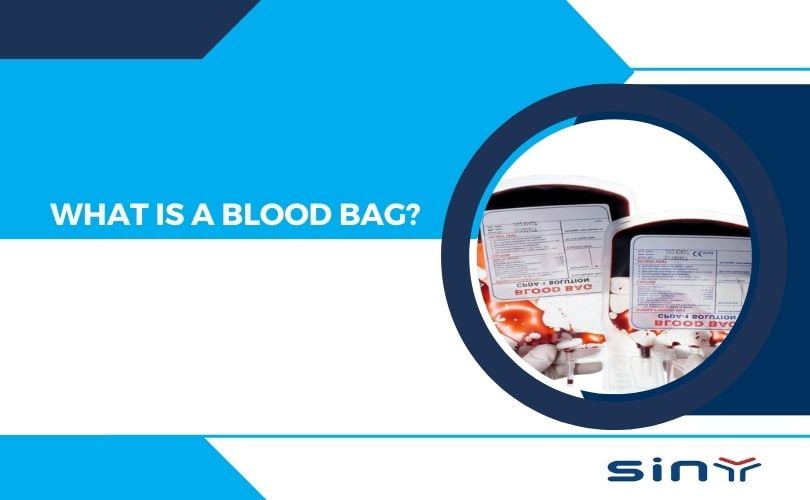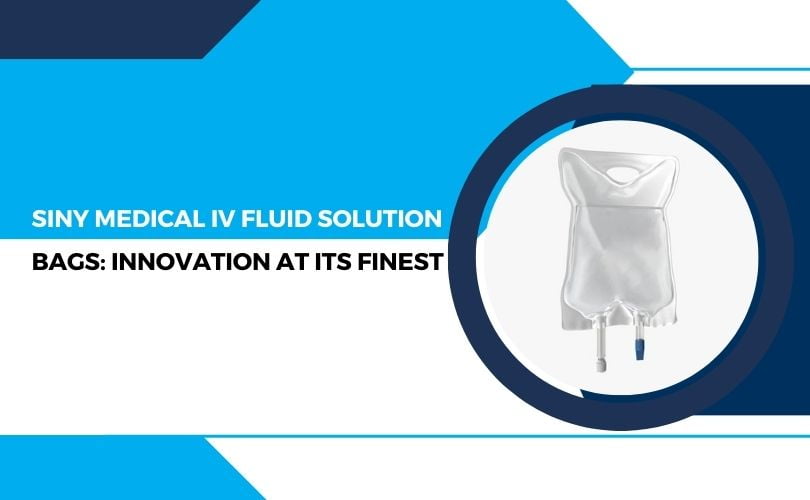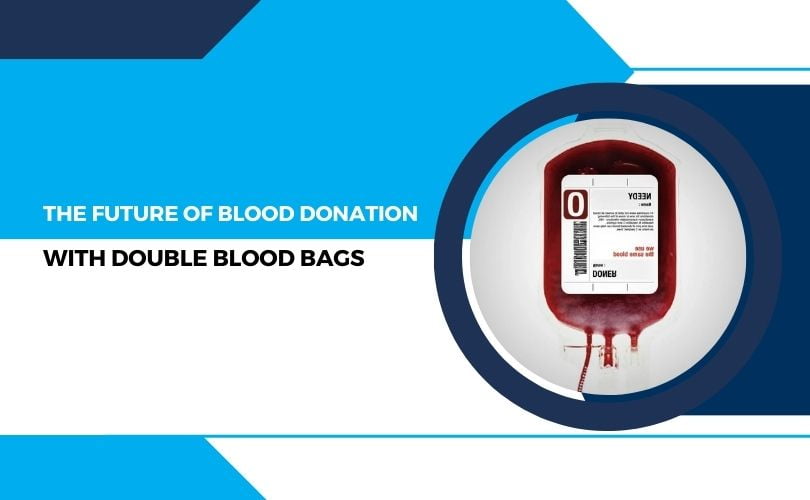High-quality Sinymedical Blood Bags have raised the bar for whole blood collection, processing, transfusion of blood components, and storage. Our Blood Bags, which are leak-proof and ideal for the safe collection, storage, and administration of whole human blood and its components, pose no risk of contamination or air embolism. Pre-donation Sampling Bags, Safety Caps, and Safety Needle shields are included with the siny Blood Bag.
Table of Contents
- 1 What are blood bags?
- 2 Standard Blood Bag
- 3 Filtration System
- 4 Others
- 5 Single Blood Bag
- 6 Double Blood Bag
- 7 Triple CPDA-1 and CPD/SAG-M
- 8 Quadruple CPDA-1 and CPD/SAG-M
- 9 Top & Bottom Triple Blood Bag
- 10 Top and Bottom Quadruple Blood Bag
- 11 Transfer Bag
- 12 Platelet Storage Bag
- 13 Pooling System
- 14 Pediatric Blood Bag System
- 15 Filtration System
- 16 Applications Beyond Transfusions: Specialized Blood Bags
- 17 Advantages and Disadvantages of Blood Bags
- 18 Final Summary
- 19 FAQs: Blood Bag
What are blood bags?
These are the disposable biomedical transparent flexible polyvinyl chloride(PVC) containers designed to collect, process, and store the whole blood and blood components.
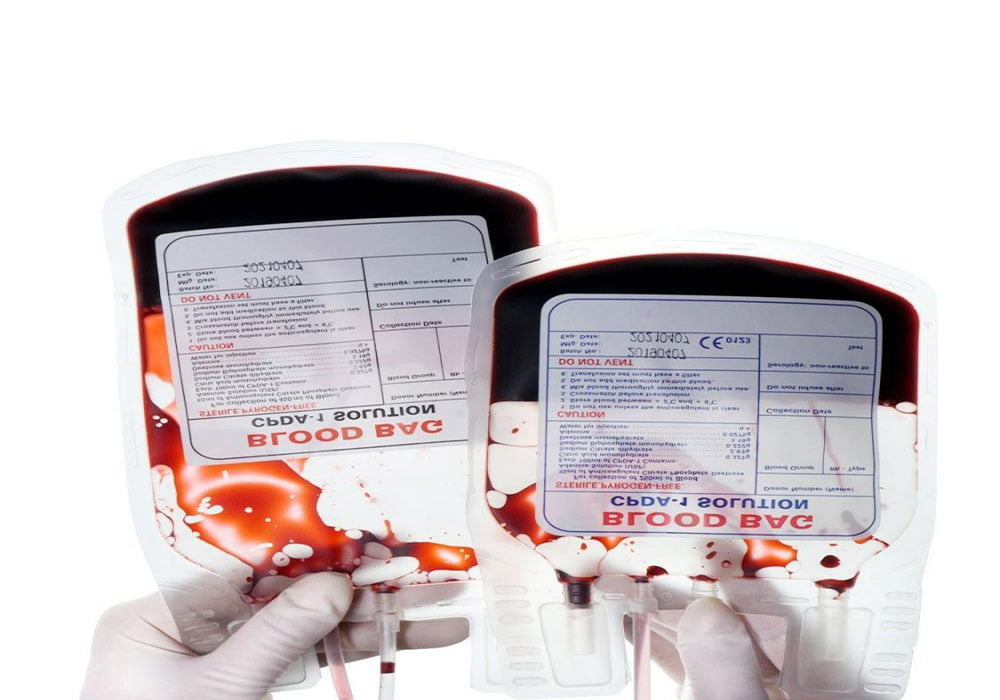
The Genesis of Blood Bags: A Historical Prelude
Blood bags have a profound history, evolving from rudimentary vessels to the sophisticated, sterile containers we know today. Initially, glass bottles were used for blood storage, but they posed significant challenges. Enter the blood bag, a flexible, sterile pouch that revolutionized blood collection and preservation.
Standard Blood Bag
- Single Blood Bag
- Double Blood Bag
- Triple CPDA-1 and CPD/SAG-M
- Quadruple CPDA-1 and CPD/SAG-M
- Top and Bottom Triple Blood Bag
- Top and Bottom Quadruple Blood Bag
- Transfer Bag
- Platelet Storage Bag
- Pooling System
- Pediatric Blood Bag System
Filtration System
- Red Cell Filtration System
- Top & Bottom Red Cell Filtration Systems
- Whole Blood Filtration System
- Bedside Filtration System
- Laboratory/Blood Bank Filtration System
- Platelet Pooling Filtration System
Others
- Animal Blood Bag/Media Bag
- Cord blood collection bag
- Auto-transfusion Bag
Single Blood Bag
For the collection of whole blood, storage, and transfusion of the single blood components. The primary bag contains CPDA-1 or CPD anticoagulant solution.
This Single Blood Bag Manufacturer is a reliable, efficient, and easy-to-use device for safely collecting, storing and transferring blood samples. The device comes with a durable and lightweight construction, making it easy to transport and use in a variety of settings.
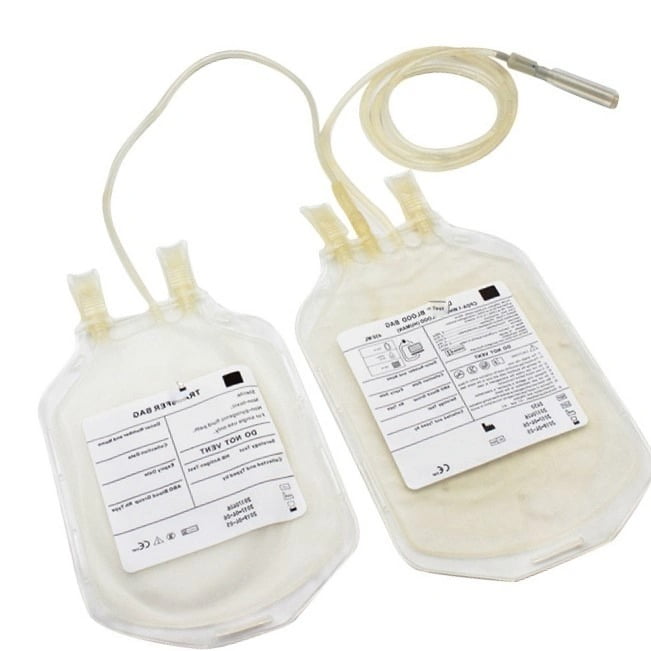
Needle Gauge Size: Available in 16G or 17G
Anticoagulant/Additive Solution: CPDA or CPD
Primary Bag Capacity: 150ml. 250ml. 350ml. 450ml. 500ml
Double Blood Bag
whole double blood collection and separation of two different blood
Components: red blood cells and plasma, obtained through the process of centrifugation and separation. The primary bag contains CPDA-1 anticoagulant solution.
The Double Blood Bag by Manufacturer! This innovative product provides a simple and effective solution for storing and transporting blood or blood products.
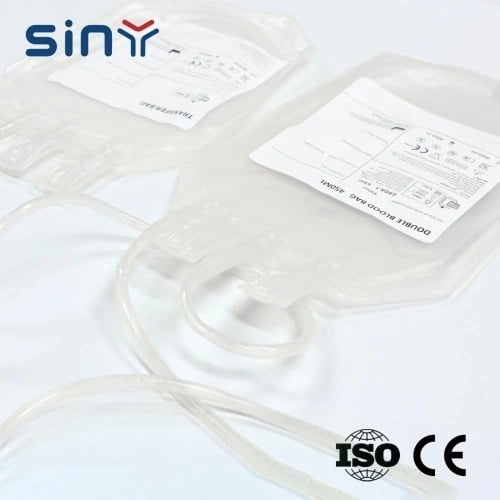
Needle Gauge Size: Available in 16G or 17G
Anticoagulant/Additive Solution: CPDA or CPD
Primary Bag Capacity: 150ml. 250ml. 350ml. 450ml. 500ml
Satellite Bag Capacity: Available from 150 to 500 mL
Triple CPDA-1 and CPD/SAG-M
Triple CPDA-1 and CPD/SAG-M
For whole blood collection and separation of 3 different blood components: red blood cells, plasma, and platelet concentrate or cryoprecipitate obtained through the process of centrifugation and separation.
The triple blood bag system is available with CPDA-1 or CPD/SAG-M anticoagulant solutions. The 5-day platelet storage bag is optional.
Needle Gauge Size: Available in 16G or 17G
Anticoagulant/Additive Solution: CPDA-1 or CPD+SAG-M
Primary Bag Capacity: 250 ml, 350 ml, 450 ml, 500 ml
Satellite Bag Capacity: Available from 150 to 500 mL
Quadruple CPDA-1 and CPD/SAG-M
PRP Method
For whole Quadruple Blood Bag collection and separation of 4 different blood components – plasma, red blood cells, platelets, and cryoprecipitate, obtained through the process of centrifugation and separation.
BC Method
For whole blood collection and separation of 3 different blood components—leucodepleted plasma, leucodepleted red blood cells, and platelets—from the buy coat, obtained through the process of centrifugation and separation. The quadruple blood bag system is available with CPDA-1 or CPD/SAG-M anticoagulant solutions. The 5-day platelet storage is optional.
Needle Gauge Size: Available in 16G or 17G
Anticoagulant/Additive Solution: CPDA-1 or CPD+SAG-M
Primary Bag Capacity: 250ml, 350ml, 450ml, 500ml
Satellite Bag Capacity: Available from 150 to 500 mL
Top & Bottom Triple Blood Bag
For whole blood collection and separation of 3 different blood components—red blood cells, plasma, and buffy coat—obtained through the process of centrifugation and separation.
The primary bag contains a CPD anticoagulant solution, and one satellite bag contains a SAG-M additive solution for red blood cell preservation.
Needle Gauge Size: Available in 16G or 17G
Anticoagulant/Additive Solution: CPD+SAG-M
Primary Bag Capacity: 350 ml, 450 ml, and 500 ml
Satellite Bag Capacity: Available from 150 to 500 mL
Top and Bottom Quadruple Blood Bag
For whole blood collection and separation of different blood components—red blood cells, plasma, and buffy coat—obtained through the process of centrifugation and separation.
The primary bag contains a CPD anticoagulant solution, and one satellite bag contains a SAG-M additive solution for red blood cell preservation. One satellite bag is for 5-day platelet storage.
Needle Gauge Size: Available in 16G or 17G
Anticoagulant/Additive Solution: CPD+SAG-M
Primary Bag Capacity: 350 ml, 450 ml, and 500 ml
Satellite Bag Capacity: Available from 150 to 500 mL
Transfer Bag
The transfer bag is available from 150 mL to 500 mL. It is designed for the transfer of blood components from whole blood.
Needle Gauge Size: For sterile connection or spikes
Primary Bag Capacity: Available from 150 to 500 mL
Platelet Storage Bag
A platelet storage bag with the plasticizer TOTM has high oxygen permeability for platelet storage for at least five days.
Needle Gauge Size: For sterile connection or spikes
Primary Bag Capacity: Available from 600 to 1000 mL
Pooling System
The pooling system is for platelet pooling or buffy coat pooling.
Needle Gauge Size: Spike
Primary Bag Capacity: Available from 600 to 1000 mL
Pediatric Blood Bag System
Pediatric Blood Collection Bag
The Pediatric Blood Collection Bag is made of high-grade medical-grade PVC for maximum safety and convenience. Collected blood can be divided and transferred into four equal pediatric-size bags. The primary bag contains CPDA-1 anticoagulant solution.
Needle Gauge Size: Available in 16G or 17G
Anticoagulant /Additive Solution: CPDA-1
Primary Bag Capacity:450mL
Satellite Bag Capacity: Available from 100mL to 150mL
Multiple Pediatric Blood Transfer Bag
Multiple Pediatric Blood Transfer Bag is of high-grade PVC for maximum safety and convenience which can allow blood to be divided and transferred into four equal pediatric-sized bags.
Needle Gauge Size: For sterile connection or spikes
Primary Bag Capacity: Available from 100mL to 150mL
Filtration System
Red Cell Filtration System
For whole blood collection and in-line filtration of red blood cells.
Needle Gauge Size: Available in 16G or 17G
Anticoagulant/Additive Solution: CPD+SAG-M
Primary Bag Capacity: 350 ml, 450 ml, and 500 ml
Satellite Bag Capacity: Available from 150 to 500 mL
Top & Bottom Red Cell Filtration Systems
For whole blood collection and in-line filtration of red blood cell components, obtaining plasma, uncoded red blood cells, and platelet-rich cells through the process of centrifugation and separation.
Needle Gauge Size: Available in 16G or 17G
Anticoagulant/Additive Solution: CPD+SAG-M
Primary Bag Capacity: 350 ml, 450 ml, and 500 ml
Satellite Bag Capacity: Available from 150 to 500 mL
Whole Blood Filtration System
For whole blood collection and in-line filtration of whole blood components, obtaining leucoded red blood cells and leucoded plasma through the process of centrifugation and separation.
Needle Gauge Size: Available in 16G or 17G
Anticoagulant/Additive Solution: CPD+SAG-M
Primary Bag Capacity: 350 ml, 450 ml, and 500 ml
Satellite Bag Capacity: Available from 150 to 500 mL
Bedside Filtration System
For filtration of whole blood and RBCs.
Laboratory/Blood Bank Filtration System
For filtration of whole blood and RBCs.
Needle Gauge Size: Spike
Primary Bag Capacity: 500 mL
Platelet Pooling Filtration System
For in-line filtration of platelet pooling or buffy coat pooling.
Needle Gauge Size: For sterile connection or spikes
Primary Bag Capacity: Available from 600 to 1000 mL
Satellite Bag Capacity: Customized
Cord Blood Collection Bag
For collecting the umbilical cord blood after the birth of the baby.
The primary bag contains a CPD anticoagulant solution.
Needle Gauge Size: Available in 14G or 16G
Anticoagulant/Additive Solution: CPD
Primary Bag Capacity: 250 mL. 350 mL
Applications Beyond Transfusions: Specialized Blood Bags
Blood bags extend beyond routine transfusions. Specialized variations, like those for pediatric use, come with unique features such as smaller capacities and specific anticoagulant solutions. Additionally, filtration systems within certain bags ensure the removal of impurities, guaranteeing the utmost safety in medical procedures.
Advantages and Disadvantages of Blood Bags
Blood bags have revolutionized the landscape of blood collection, storage, and transfusion, offering numerous advantages.
Sterility and Safety:
Advantage: Blood bags provide a sterile environment, minimizing the risk of infections during transfusions.
Impact: Enhances patient safety by reducing the likelihood of complications.
Flexibility in Storage and Transportation:
Advantage: Blood bags are lightweight and portable, allowing for easy storage and transportation.
Impact: Facilitates efficient blood supply management, especially in emergencies and remote locations.
Component Separation:
Advantage: Blood bags enable the separation of different blood components, such as red blood cells, plasma, and platelets.
Impact: Optimizes the use of donated blood, allowing specific components to be used for various medical conditions.
Extended Shelf Life:
Advantage: The anticoagulants and preservatives in blood bags extend the shelf life of blood components.
Impact: Enables better inventory management and reduces wastage, ensuring a stable blood supply.
Reduced Clotting Risks:
Advantage: Anticoagulants in blood bags prevent clotting, ensuring the viability of blood components.
Impact: Minimizes the risk of clot-related complications during transfusions.
Increased Donor Convenience:
Advantage: Blood bags offer a more comfortable and convenient donation experience for donors.
Impact: Encourages regular blood donations, contributing to a consistent and sustainable blood supply.
Final Summary
A blood bag is more than just a vessel; it is a lifeline connecting donors to recipients. The evolution from glass bottles to the contemporary, diverse range of blood bags mirrors the progress of medical science in safeguarding human lives. Understanding the nuances of blood bags allows us to appreciate their indispensable role in modern healthcare—a role that continues to evolve, saving lives one bag at a time
FAQs: Blood Bag
What is the function of the blood bag?
The primary function of a blood bag is to provide a sterile and secure environment for the collection, storage, and transportation of blood and its components. Blood bags play a crucial role in ensuring the safety of both donors and recipients during blood transfusions and other medical procedures.
What are the bags called that hold blood?
The bags that hold blood are commonly referred to as blood bags. These specialized bags are designed with sterile materials and configurations that allow for the separation of different blood components, ensuring precise and efficient use in medical treatments.
How much blood is in a bag?
The amount of blood in a bag can vary based on its purpose and configuration. Single blood bags typically hold around 350 to 500 milliliters of blood, while bags for specific components like platelets or plasma may have different capacities.
How many days can a blood bag be stored?
The storage duration of a blood bag depends on the specific blood component and the preservatives used. Generally, red blood cells can be stored for up to 42 days, platelets for around 5 days, and plasma for up to a year when frozen. These storage times ensure the maintenance of blood quality for safe transfusions.
How do you preserve blood bags?
Blood bags are preserved by adding anticoagulants and preservatives during the collection process. Anticoagulants prevent blood clotting, while preservatives maintain the viability of blood components. Proper storage conditions, including temperature control, also contribute to the preservation of blood bags.
How many bags of blood can you give?
The number of bags of blood an individual can give depends on factors such as their weight, health status, and the blood donation guidelines of the blood collection facility. Generally, during a standard whole blood donation, a person can give around one unit of blood, which is approximately 450 milliliters.


